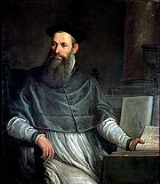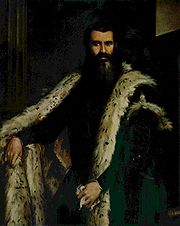
Portrait of Daniele Barbaro
Encyclopedia
The Portrait of Daniele Barbaro is a painting by the Italian Renaissance master Paolo Veronese
(from circa 1565-1567), belonging to the collection of the Rijksmuseum Amsterdam.
There is another portrait by Veronese in the Pitti Palace, Florence (where Barbaro is dressed as a Venetian aristocrat).
Barbaro was also portrayed by Titian
.

was a member of the Venetian aristocracy (see Barbaro family). He was an important prelate, humanist and architectural theorist, who commissioned a number of works from Veronese. Veronese had been involved directly with Barbaro and his brother Marcantonio Barbaro
, decorating the Villa Barbaro
, Maser
, which Palladio designed.
Here Barbaro is portrayed sitting in the audience posture (reserved normally for Popes and cardinals) in recognition of his status as cardinal and Patriarch of Aquileia
.
The book standing up is the La Practica della Perspettiva, Barbaro's treatise on artistic perspective. The other volume on the table is Barbaro's "Commentary" on Vitruvius
' De architectura
, which has illustrations by Andrea Palladio
.
Barbaro's Commentary on Vitruvius was published in Italian in 1556, but the portrait may be linked to the publication of a second edition in Latin in the 1560s.
Paolo Veronese
Paolo Veronese was an Italian painter of the Renaissance in Venice, famous for paintings such as The Wedding at Cana and The Feast in the House of Levi...
(from circa 1565-1567), belonging to the collection of the Rijksmuseum Amsterdam.
There is another portrait by Veronese in the Pitti Palace, Florence (where Barbaro is dressed as a Venetian aristocrat).
Barbaro was also portrayed by Titian
Titian
Tiziano Vecelli or Tiziano Vecellio Tiziano Vecelli or Tiziano Vecellio Tiziano Vecelli or Tiziano Vecellio (c. 1488/1490 – 27 August 1576 better known as Titian was an Italian painter, the most important member of the 16th-century Venetian school. He was born in Pieve di Cadore, near...
.

Background
Daniele BarbaroDaniele Barbaro
Daniele Matteo Alvise Barbaro was an Italian translator of, and commentator on, Vitruvius. He also had a significant ecclesiastical career, reaching the rank of Cardinal....
was a member of the Venetian aristocracy (see Barbaro family). He was an important prelate, humanist and architectural theorist, who commissioned a number of works from Veronese. Veronese had been involved directly with Barbaro and his brother Marcantonio Barbaro
Marcantonio Barbaro
Marcantonio Barbaro was an Italian diplomat of the Republic of Venice.-Family:He was born in Venice into the aristocratic Barbaro family...
, decorating the Villa Barbaro
Villa Barbaro
Villa Barbaro, also known as the Villa di Maser, is a large villa at Maser in the Veneto region of northern Italy. It was designed and built by the Italian architect Andrea Palladio, with frescos by Paolo Veronese and sculptures by Alessandro Vittoria for Daniele Barbaro, Patriarch of Aquileia...
, Maser
Maser
A maser is a device that produces coherent electromagnetic waves through amplification by stimulated emission. Historically, “maser” derives from the original, upper-case acronym MASER, which stands for "Microwave Amplification by Stimulated Emission of Radiation"...
, which Palladio designed.
Here Barbaro is portrayed sitting in the audience posture (reserved normally for Popes and cardinals) in recognition of his status as cardinal and Patriarch of Aquileia
Patriarch of Aquileia
The Patriarch of Aquileia was an office in the Roman Catholic Church. During the Middle Ages the Patriarchate of Aquileia was a temporal state in Northern Italy. The Patriarchate of Aquileia as a church office was suppressed in 1752....
.
The book standing up is the La Practica della Perspettiva, Barbaro's treatise on artistic perspective. The other volume on the table is Barbaro's "Commentary" on Vitruvius
Vitruvius
Marcus Vitruvius Pollio was a Roman writer, architect and engineer, active in the 1st century BC. He is best known as the author of the multi-volume work De Architectura ....
' De architectura
De architectura
' is a treatise on architecture written by the Roman architect Vitruvius and dedicated to his patron, the emperor Caesar Augustus, as a guide for building projects...
, which has illustrations by Andrea Palladio
Andrea Palladio
Andrea Palladio was an architect active in the Republic of Venice. Palladio, influenced by Roman and Greek architecture, primarily by Vitruvius, is widely considered the most influential individual in the history of Western architecture...
.
Barbaro's Commentary on Vitruvius was published in Italian in 1556, but the portrait may be linked to the publication of a second edition in Latin in the 1560s.

